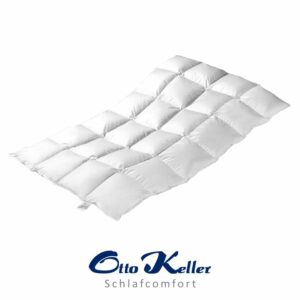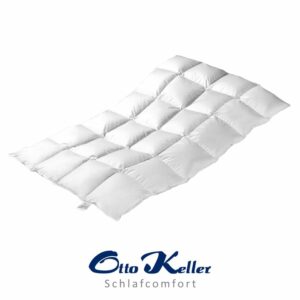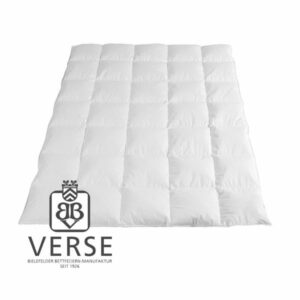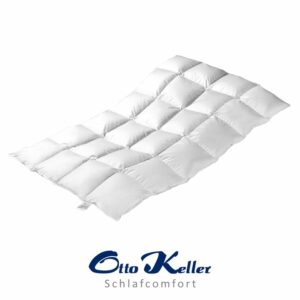Goose Down Winter Duvet (12.0 Tog)
12.0 Tog goose down winter duvets are cozy and warm enough to protect you from winter chills. Designed to shelter you from the cold without compromising on comfort and breathability, they are suitable for use during the colder months of the year and in unheated or poorly insulated bedrooms. These premium down duvets are constructed using the baffle-box technique, a method which provides optimal insulation using the softest of materials. Premium-quality down has exceptionally high fill power, meaning it does more with less, providing better insulation without extra weight. Duvets with 100% down filling will be even lighter while providing just as much warmth, if not more, than those with 90% down.
Available in all sizes from single to super king, these duvets are the ideal protection against harsh winter nights. All our duvets are premium products with natural filling of at least 90% down and are produced in workshops which exercise extensive quality control and maintain high standards of excellence.
Showing 1–12 of 153 results
-
Otto Keller Classic 12.0 tog (Winter) 135 x 200cm (Single)
Filling: 90% European duck down, 10% small feathers Fill power: 500 cuin Fill weight: 900 g Fabric: Ne 60 Squares: 4x6 Stitching: Stitched with inner baffles, 1.5 cm £ 159.00 ex VAT -
Otto Keller Prestige 12.0 tog (Winter) 135 x 200cm (Single)
Filling: 90% Siberian goose down, 10% small feathers Fill power: 600 cuin Fill weight: 840 g Fabric: Ne 60 Squares: 4x6 Stitching: Stitched with inner baffles, 1.5 cm £ 202.00 ex VAT -
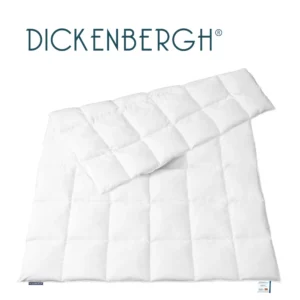
Dickenbergh Westfalen 12.0 tog (Winter) 135 x 200cm (Single)
Filling: 90% Westphalian goose down, 10% small feathers Fill power: 600 cuin Fill weight: 865 g Fabric: Ne 60 Squares: 6x8 Stitching: Stitched with inner baffles, 2 cm £ 269.00 £ 215.20 ex VAT -

Dickenbergh Westfalen 12.0 tog (Winter) 135 x 220cm
Filling: 90% Westphalian goose down, 10% small feathers Fill power: 600 cuin Fill weight: 950 g Fabric: Ne 60 Squares: 6x10 Stitching: Stitched with inner baffles, 2 cm £ 289.00 £ 231.20 ex VAT -
Otto Keller Classic 12.0 tog (Winter) 200 x 200cm (Double)
Filling: 90% European duck down, 10% small feathers Fill power: 500 cuin Fill weight: 1340 g Fabric: Ne 60 Squares: 6x6 Stitching: Stitched with inner baffles, 1.5 cm £ 239.00 ex VAT -
Bielefelder Verse Classic 12.0 tog (Winter) 135 x 200cm (Single)
Filling: 90% Hungarian duck down, 10% small feathers Fill power: 680 cuin Fill weight: 900 g Fabric: Ne 60 Squares: 4x6 Stitching: Stitched with inner baffles, 4 cm £ 246.00 ex VAT -
Otto Keller Premium 12.0 tog (Winter) 135 x 200cm (Single)
Filling: 100% Siberian goose down Fill power: 700 cuin Fill weight: 720 g Fabric: Ne 90 Squares: 4x6 Stitching: Stitched with inner baffles, 1.5 cm £ 253.00 ex VAT -

Dickenbergh Niedersachsen 12.0 tog (Winter) 135 x 200cm (Single)
Filling: 90% Canadian Goose Down, 10% small feathers Fill power: 635 cuin Fill weight: 845 g Fabric: Ne 80 Squares: 6x8 Stitching: Stitched with inner baffles, 2 cm £ 329.00 £ 263.20 ex VAT -
Otto Keller Classic 12.0 tog (Winter) 230 x 220cm (King)
Filling: 90% European duck down, 10% small feathers Fill power: 500 cuin Fill weight: 1640 g Fabric: Ne 60 Squares: 7x6 Stitching: Stitched with inner baffles, 1.5 cm £ 282.00 ex VAT -

Dickenbergh Niedersachsen 12.0 tog (Winter) 135 x 220cm
Filling: 90% Canadian Goose Down, 10% small feathers Fill power: 635 cuin Fill weight: 930 g Fabric: Ne 80 Squares: 6x10 Stitching: Stitched with inner baffles, 2 cm £ 359.00 £ 287.20 ex VAT -
Otto Keller Prestige 12.0 tog (Winter) 200 x 200cm (Double)
Filling: 90% Siberian goose down, 10% small feathers Fill power: 600 cuin Fill weight: 1260 g Fabric: Ne 60 Squares: 6x6 Stitching: Stitched with inner baffles, 1.5 cm £ 311.00 ex VAT -

Dickenbergh Mecklenburg 12.0 tog (Winter) 135 x 200cm (Single)
Filling: 100% Polish goose down Fill power: 725 cuin Fill weight: 790 g Fabric: Ne 90 Squares: 6x8 Stitching: Stitched with inner baffles, 2 cm £ 389.00 £ 311.20 ex VAT
What makes a good 12.0 tog goose down duvet?
Medium to Large Boxes
The size of the ‘boxes’ which make up a down duvet is a good visual indicator of its relative warmth. The more filling within one of these quilted squares (down chambers), the more efficient the insulation it provides. Therefore Winter duvets will generally have fewer boxes than summer duvets. The boxes will in turn be much larger. As a standard, a 135 cm x 200 cm Winter duvet will have either 48 boxes arranged in a 6 x 8 grid, or 24 in a 4 x 6 grid. Remember that fill power is the ultimate measure of insulation. Expressed in CUIN, the higher the fill power, the more efficient a duvet is at trapping warmth with the least volume of filling required.
Ventilation
Ventilation refers to the air permeability of a down duvet. Winter duvets are sewn with baffles of 3 to 4 cm in length, which allows the down to expand to its maximum capacity and prevents air from escaping through the seams.
Tog Rating
We use tog rating as an easy-to-understand measurement of insulation. A higher tog means that a duvet is suitable for colder environments. A tog rating of 12.0 indicates a warm, Winter duvet. More information can be found on our page about the tog system.
Down Quality
European Standard EN 12934 regulates the categorisation and naming of the filling material in bedding based on the proportion of new down and the types of poultry used. Only Class 1 down fillings may bear the quality rating “new”. All products on Downduvet.co.uk are filled with the best, Class 1 filling.
Anti-allergy
Experience shows that duvets with fabric of Ne 30 or higher are suitable for use by people with dust mite allergies. Premium down comforters have high-quality covers ranging from Ne 40 to Ne 155. On this website, you can see the Ne of each duvet under its product details. Additional protection is provided by duvets with the NOMITE label, which we recommend for allergy sufferers.
